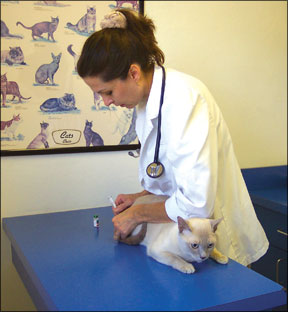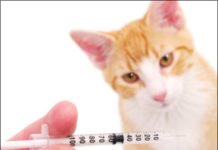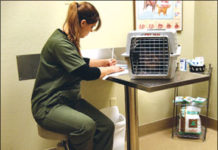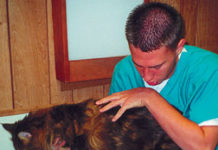Ask Elizabeth: January 2012
We adopted a new kitten from a local rescue group last month, and she is just perfect. Although she had been tested for the feline leukemia virus and FIV by the terrific group that saved her from the street, we took her to our veterinarian right away so that she could be examined before we introduced her to our two older cats. After a clean bill of health, we brought Bunny home, and she has become a well-integrated part of the family. The problem is that before we scheduled her spay surgery, she came into heat. What a scene!
Panleukopenia: A Lethal Threat
Among all agents of feline illness and mortality, few if any are more pernicious — especially to kittens — than feline panleukopenia virus (FPV). The disease is also known in some circles as “distemper,” a misnomer, notes Fred Scott, DVM, PhD, a professor emeritus of virology in Cornell University’s College of Veterinary Medicine and founding director of the Cornell Feline Health Center. ”Distemper” refers to a respiratory disease, and there is no respiratory component to feline panleukopenia. Cats become infected with FPV — which is classified as a parvovirus — by living in an environment that is contaminated with it or by coming in contact with the urine, feces, saliva or nasal secretions of a cat that is already infected.
Short Takes: July 2011
Thanks to the development of screening assays and vaccines for FeLV, the prevalence of persistently infected cats has decreased. Recent studies indicate that the FeLV genetic material remains in cats exposed to the virus, though viral replication may not occur. Concern exists that this persistent viral DNA may ultimately contribute to development of lymphoma in cats.
Short Takes: October 2010
Feline leukemia (FeLV) and feline immunodeficiency virus (FIV) are both serious pathogens of cats that often result in lifelong infection. Routine testing - as well as testing of clinically ill cats - is recommended, and is usually performed by using in-clinic test kits. For FeLV, these assays detect a viral protein, whereas a virus-specific antibody is detected for FIV. A new test system, Anigen Rapid FIV Ab/FeLV Ag test kit is now available on the European market. These investigators examined the diagnostic sensitivity and specificity of this new test kit on 300 samples using western blot as the gold standard for FIV infection, and polymerase chain reaction for FeLV infection; in addition, results were compared to those attained using the most commonly-used kit made by IDEXX (SNAP Combo).
Understand Feline Lymphatic Disease
The feline lymphatic system influences every aspect of a cats physical health According to Margaret McEntee, DVM, a professor of oncology at Cornell Universitys College of Veterinary Medicine, owners should be able to recognize the signs that could indicate feline lymphoma, a potentially deadly cancer of the lymphatic system that can affect many areas of a cats body, including its liver, gastrointestinal system spleen and skin. Lymphoma is the most frequently observed of all feline cancers, explains Dr. McEntee - even more common than mammary cancer. At the Cornell University Hospital for Animals (CUHA), she notes, "We see about 40 cats or so each year that have this disease, and the incidence may be even higher than that at other veterinary clinics."
FeLV and FIV Testing: Important
Among all causes of lethal feline disease, none should be taken more seriously by cat owners than those caused by two specific submicroscopic organisms: feline leukemia virus (FeLV) and feline immunodeficiency virus (FIV). Although these viruses are somewhat different in appearance and in the manner in which they exact their toll on feline health, infection with either one of them, if undetected, is capable of causing a cats premature death. All Too Common. To make matters worse, FeLV and FIV infections are by no means rare. Recent estimates indicate that two percent to four percent of the 83 million or so cats in the U.S. harbor one or both of these two viruses.
Testing for FIV and FeLV
Among all causes of lethal feline disease, none should be taken more seriously by cat owners than those caused by two specific submicroscopic organisms: feline leukemia virus (FeLV) and feline immunodeficiency virus (FIV). Although these viruses are somewhat different in appearance and in the manner in which they exact their toll on feline health, infection with either one of them, if undetected, is capable of causing a cats premature death. To make matters worse, FeLV and FIV infections are by no means rare. Recent estimates indicate that two percent to four percent of the 83 million or so cats in the U.S. harbor one or both of these two viruses.
FeLV: A Lethal Threat
Among all causes of severe feline disease, none is more prevalent than feline leukemia virus (FeLV), a submicroscopic organism associated with the illness and death of more cats worldwide than any other infectious agent. This virus - which is spread through the urine, saliva, nasal secretions or milk of infected animals - is currently recognized as the chief causative agent of fatal infectious disease among U.S. domestic cats.
Ask Dr. Richards: 08/05
I am the owner of Tassu, a 10-month-old cat I adopted from an animal shelter. A few weeks after I had her neutered, I noticed her behavior had changed. She seemed very lazy and not really interested in any physical activities, and she also lost her appetite. I took her to my veterinarian, and he found that she had pale gums, so he recommended she be tested for infection with feline leukemia virus (FeLV). To…
Has Your Cats Behavior Changed?
Losing weight and sleeping more than usual can be subtle signs of illness.
Caring for the Cat With Chronic Illness
Would you be able to provide at-home care for your cat? Heres what to consider.
Ask Dr. Richards: 02/04
Question: About two weeks ago our 17-year-old cat, Goldie, went blind (at least thats when we first noticed her bumping into things). Our veterinarian...
















